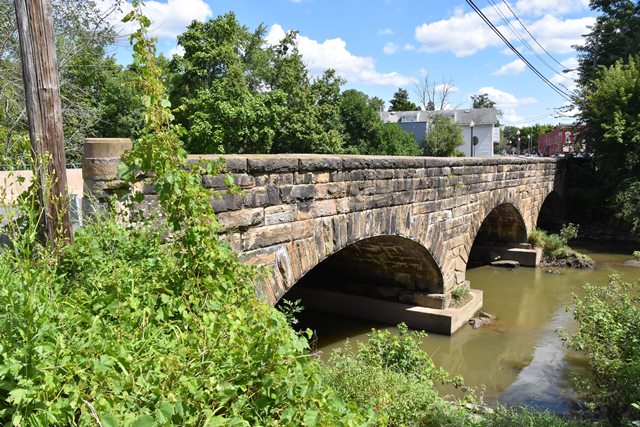We Recommend:
Bach Steel - Experts at historic truss bridge restoration.
BridgeHunter.com Phase 1 is released to the public! - Visit Now
Market Street Bridge

Primary Photographer(s): Nathan Holth
Bridge Documented: August 24, 2019
Canal Fulton: Stark County, Ohio: United States
2001
45.0 Feet (13.7 Meters)
126.0 Feet (38.4 Meters)
25.6 Feet (7.8 Meters)
3 Main Span(s)
7633041

View Information About HSR Ratings
Bridge Documentation
This attractive stone arch bridge is located in the heart of Canal Fulton. The original stone railing remains on one side of the bridge, while the other side has a concrete barrier and a sidewalk with modern railing, but with a cast iron end post that may be from part of the original railing.
View Archived National Bridge Inventory Report - Has Additional Details and Evaluation
Information and Findings From Ohio's Historic Bridge InventorySetting/Context The bridge carries a 2 lane street and sidewalk over the stream in Canal Fulton. According to ODOT data, the bridge is in the Canal Fulton HD (NR 1982). The bridge is contributing to the district because it falls within the 1825-1949 period of significance. Physical Description The 3 span, 126'-long, stone arch bridge has ashlar parapet (one side only), spandrel walls and arch rings. A sidewalk has been added to one side with metal panel railing and safety-shape barrier (2001). Canal Fulton HD. Rehabilitated 2000. PID 20447. Bridge award 2001. Excellent condition. Railing has been hit by vehicle and stones need repaired. Field checked on 7/10/06. Integrity Rehabilitated in 2001 with the addition of a sidewalk to one side. Summary of Significance A sidewalk and railing have been added to one
elevation as part of a 2001 rehabilitation project that was found to
have no adverse effect. The bridge retains its original appearance from
the other elevation and retains sufficient integrity to convey its
technological significance. The bridge is a contributing resource in the
Canal Fulton HD (NR 1982). Justification A well represented bridge type throughout the state for both bridges and culverts, stone arch bridges date from the mid 1830s and the building of the National Road through Belmont Co. Many are superbly proportioned and constructed by local contractors. They were built through World War I, particularly during the later years in park settings. More than 125 examples remain. This example has moderate significance based on its date of construction, detailing, and historic contexts). Bridge Considered Historic By Survey: Yes |
![]()
Photo Galleries and Videos: Market Street Bridge
Bridge Photo-Documentation
Original / Full Size PhotosA collection of overview and detail photos. This gallery offers photos in the highest available resolution and file size in a touch-friendly popup viewer.
Alternatively, Browse Without Using Viewer
![]()
Bridge Photo-Documentation
Mobile Optimized PhotosA collection of overview and detail photos. This gallery features data-friendly, fast-loading photos in a touch-friendly popup viewer.
Alternatively, Browse Without Using Viewer
![]()
Maps and Links: Market Street Bridge
Coordinates (Latitude, Longitude):
Search For Additional Bridge Listings:
Bridgehunter.com: View listed bridges within 0.5 miles (0.8 kilometers) of this bridge.
Bridgehunter.com: View listed bridges within 10 miles (16 kilometers) of this bridge.
Additional Maps:
Google Streetview (If Available)
GeoHack (Additional Links and Coordinates)
Apple Maps (Via DuckDuckGo Search)
Apple Maps (Apple devices only)
Android: Open Location In Your Map or GPS App
Flickr Gallery (Find Nearby Photos)
Wikimedia Commons (Find Nearby Photos)
Directions Via Sygic For Android
Directions Via Sygic For iOS and Android Dolphin Browser
USGS National Map (United States Only)
Historical USGS Topo Maps (United States Only)
Historic Aerials (United States Only)
CalTopo Maps (United States Only)

